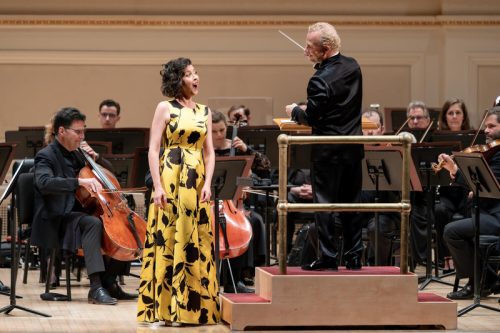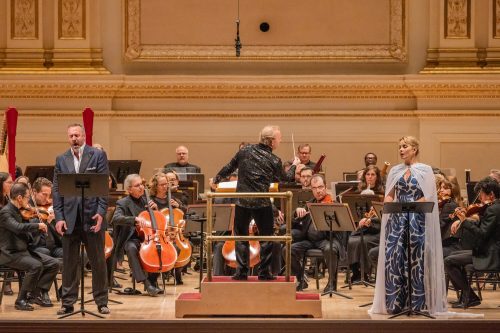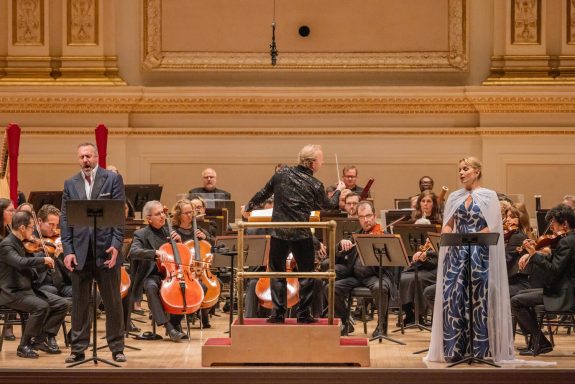 United States Various: Soloists, MET Orchestra / Yannick Nézet-Séguin (conductor). Carnegie Hall, New York, 11 and 14.6.2024. (ES-S)
United States Various: Soloists, MET Orchestra / Yannick Nézet-Séguin (conductor). Carnegie Hall, New York, 11 and 14.6.2024. (ES-S)

[1] Montgomery, Mozart, Brahms: Lisette Oropesa (soprano), 11.6.2024.
Jessie Montgomery – ‘Hymn for Everyone’
Mozart – ‘Vado, ma dove?’, K.583; ‘A Berenice…Sol nascente’, K.70
Brahms – Symphony No.1
[2] Wagner, Debussy, Bartók: Elīna Garanča (mezzo-soprano), Christian Van Horn (bass-baritone), 14.6.2024.
Wagner – Overture to Der fliegende Holländer
Debussy – Suite from Pelléas et Mélisande (arr. Leinsdorf)
Bartók – Bluebeard’s Castle
In 1991, James Levine and the Metropolitan Opera Orchestra were invited to perform at Carnegie Hall during the festivities celebrating the institution’s centennial. The conductor asked the fabulous Jessye Norman to be the soloist for the performance which featured music by Berlioz and Wagner. A long-standing tradition was thus established and continues to this day. On the one hand, the instrumentalists use Carnegie Hall concerts to explore great orchestral repertoire that is unfamiliar to them. On the other, they present, in a different context, musical drama segments (or even shorter operas in their entirety), often inviting vocalists with whom they regularly collaborate.
The two June evenings that marked the conclusion of the Carnegie Hall season were no exception. Serving as an introduction was Jessie Montgomery’s ‘Hymn for Everyone’, a 2022 commission from the Chicago Symphony Orchestra. According to the composer, the work is based on a hymn that ‘just came’ to her during a long hike. The completed piece became an oblique response to the pandemic, the socio-political crisis and Montgomery’s own personal challenges. ‘It is a kind of meditation for orchestra, exploring various washes of color and timbre through each repetition of the melody’, the composer remarked in her program notes.
In his careful rendition of the 12-minute-long score, Nézet-Séguin brought forward both the slow evolution of the soundscape and the mixture of classical and Afro-American idioms that make Montgomery’s music interesting, even in the absence of more sophisticated development mechanisms.
The instrumentalists approached Brahms’s Symphony No.1 with great enthusiasm. Under Nézet-Séguin, the performance was thrilling rather than austere: though still somewhat episodic, the first movement avoided gloom, with Nézet-Séguin’s trademark grand gestures highlighting every detail. The Andante exuded tenderness and transparency, while the Scherzo bordered on fierceness. The Finale, dominated by its hymn-like ‘Ode to Joy’-inspired theme, shifted from an homage to Beethoven to the brink of Mahlerian intensity. Despite this Romantic approach, it is important to remember that Brahms was a Classicist at heart.
The second program’s arc was interesting, beginning with a descriptive, early-Wagner overture; followed by selections from Pelléas et Mélisande which, at least on the surface, contradicts everything Wagner stood for; and concluding with Bartók’s Bluebeard’s Castle, still very much indebted to Debussy’s influence in terms of Symbolist mood, eerie atmosphere and ambiguous harmonies.
On Friday night, the Overture to The Flying Dutchman effectively functioned as an abstract of the entire opera, vividly portraying individual characters with precise lines. The progression towards a cathartic denouement was marked by steps imbued with a palpable sense of inevitability.
In contrast, the suite from Pelléas et Mélisande that conductor Erich Leinsdorf assembled consists mainly of orchestral interludes and fails to capture the essence of the work. It leaves a monotonous impression of aimless wandering and inadvertently underscores the essential nature of the libretto, the ‘Tristanesque’ declamatory vocal style and the strategic use of silences to fully experience the opera. Nevertheless, despite the score’s problematic character, the interpretation was full of sensitivity, much like the more straightforward Wagnerian overture, and it was rendered with panache.
The vocal soloists – soprano Lisette Oropesa, mezzo-soprano Elīna Garanča and bass-baritone Christian Van Horn – made their debuts at the Metropolitan Opera in 2006, 2008 and 2013 respectively. Their close bonds with Nézet-Séguin and many of the instrumentalists were evident.
Oropesa was the soloist in two Mozart works: the brief and brilliant aria ‘Vado, ma dove?’, and the longer recitative and aria ‘A Berenice…Sol nascente’. The latter, a licenza composed in honor of Salzburg’s Archbishop Sigismund von Schrattenbach for the occasion of his birthday, showcases the amazing mastery of craft of a 13-year-old Mozart.
Today, with a more powerful instrument and a glorious middle range, Oropesa might have lost some of the freshness of tone she had when she was the Metropolitan’s splendid Susanna. Nevertheless, the lyric soprano’s ingenuousness, stage presence and wonderful ability to shape phrases remain unchanged. With Nézet-Séguin always knowing when the orchestra needs to scale down, Oropesa’s display of coloratura runs in ‘A Berenice’ was truly exciting.

Elīna Garanča and Christian Van Horn portrayed the protagonists in Bartók and Balász’s psychological thriller, Bluebeard’s Castle, when Judith, Bluebeard’s most recent spouse, persuades him to sequentially open locked doors, revealing rooms filled with instruments of torture, arms, jewelry and flowers, each painted in resplendent and varied color schemes. In this version, the voice of the initial narrator was pre-recorded, and the two soloists, who were not on the stage at the beginning, positioned themselves on opposite sides of the conductor’s podium to illustrate the distance and lack of togetherness between them.
As on other occasions, having non-natives singing in Hungarian posed significant challenges. It is not just the vowel pronunciations but the unique prosody of the language overall. Furthermore, the orchestra did not sufficiently highlight the folk-influenced, diverse and asymmetric rhythmic patterns, irregular phrase lengths and unusual accents and syncopations. Despite this, the ensemble’s commitment and coordination and the contributions by sections and individuals were dazzling in terms of timbral spectrum.
Possessor of one of the most beautiful lyric-dramatic mezzo-soprano voices of today, with a powerful and flexible large-spectrum instrument, Garanča has recently excelled in interpreting Romantic femmes fatales. Portraying a character not only anchored in fin-de-siècle anxiety but also exemplary of the preoccupations of the emerging field of psychology seemed, for now, a tad unnatural for her. Despite the best efforts to render a range of emotions – naïveté, passion, fear, determination – that mark Judith’s inquisitive exploits, the performance did not fully resonate.
Bass-baritone Christian Van Horn was steady and intense in the role of Bartók’s enigmatic Bluebeard. One could have wished for more variety and color in his delivery, especially in moments of great tension such as those in front of the sixth door when the word könnyek (‘tears’) is repeated multiple times in rapid succession.
The Carnegie Hall programs, with slight variations, will be repeated during the orchestra’s forthcoming Asian tour, its first. Hopefully, those performances will stand as a testament to the conductor’s and the ensemble’s dedication and versatility.
Edward Sava-Segal
